Thursday, November 1st, 2018 by Julian Karsunky
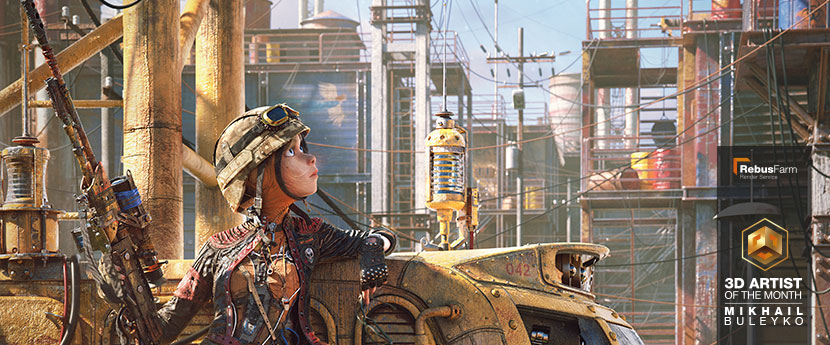
The end of the world has never looked so good! Mikhail Buleyko, our November 2018 3D Artist of the Month, envisions the remnants of a ruinous civilization in all its rusty glory. Dystopian in nature, yet vibrant in color and oozing with style, his ‘Rusty Skies’ is a real eye-catcher. A prime example in visual storytelling, its seemingly haphazard composition is a carefully crafted invitation to the viewer to immerse oneself in an alien, yet strangely cozy future.
In our interview, Mikhail talks about challenges and inspirations in the dystopian genre, offering a fascinating insight into his approach to world-building along the way. Continue reading to find out what lead to the downfall of society and get the full story behind the picture.
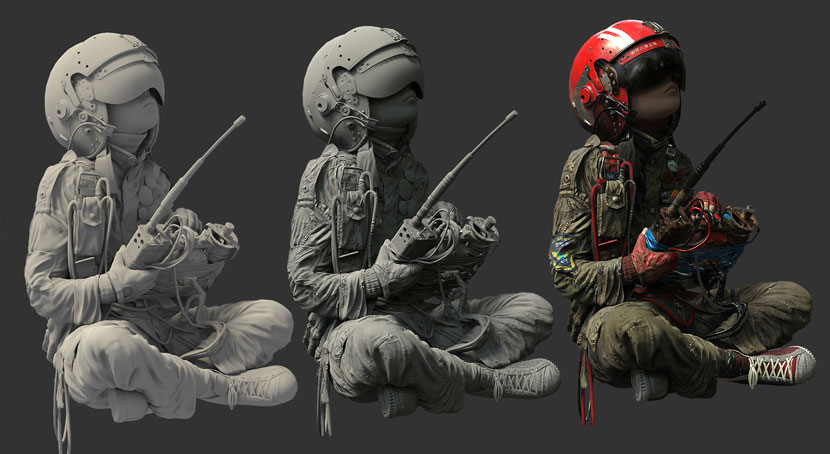 “Watch the skies. Everywhere. Keep looking.” Despite the cartoony and colorful aesthetic, the young characters give off a sense of imminent danger.
“Watch the skies. Everywhere. Keep looking.” Despite the cartoony and colorful aesthetic, the young characters give off a sense of imminent danger.
Hi Mikhail, great to have you! To start things off, please introduce yourself to our readers!
Hi everyone, my name is Mikhail Buleyko, anglicized for the convenience of western audiences as ‘Michael Black’. I’m a 36-years-old 3D artist from Rostov-on-Don, one of the largest cities in Southern Russia.
Do you recall when and how you first consciously encountered CGI?
I began using CG-technology back in 2008, when I was still working as an industrial designer. I found it to be the most efficient way of visually conveying my designs to my clients. You see, my formal education does not exactly correspond to my current occupation: I am a trained ship engineer.
When did you then decide to pursue a professional career as a 3D artist?
Around three years ago I stopped using CGI just as an auxiliary tool and decided to fully commit to it, changing my profession altogether. So I left my position as an industrial designer and got a job as a 3D artist at 747 Studios in Hamburg, Germany. That was an invaluable experience and a great start into my new work life. I still keep in touch and work remotely with them to this day.
What is your current job situation? Are you employed at the moment or freelancing full-time?
I’m currently employed at a game studio as a 3D artist, focusing on high and low poly modeling, texturing and concept art. I do take on freelance projects occasionally, but since my job naturally takes up most of my time, I’m somewhat picky when it comes to those: They have to both pique my personal interest and be not very urgent.
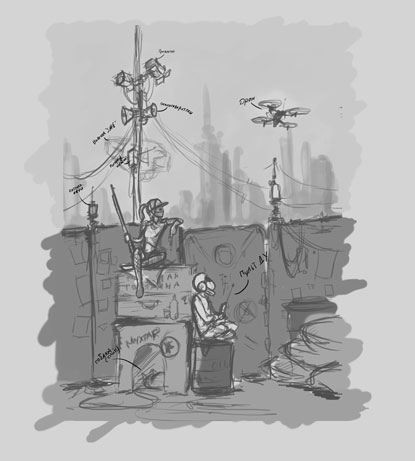 |
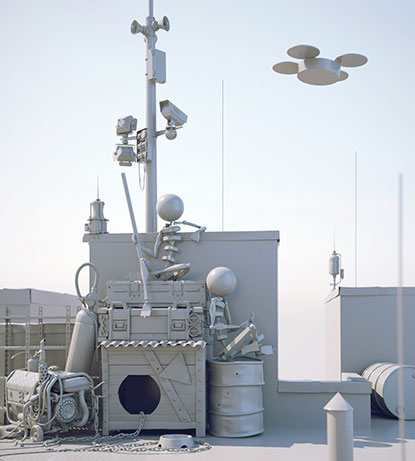 |
This progression from storyboard to a first 3D design showcases Mikhail’s impressive abilities as a concept artist.
Let us talk about your work in more detail, namely ‘Rusty Skies’. First of all, please tell us more about the origin of the image, I understand it was part of a design competition?
That’s right, ‘Rusty Skies’ was my submission for a contest held by Russian community site render.ru and mobile game developer Social Quantum between May and June 2018. The theme of the contest was ‘the end of civilization’ and the participants were to create illustrations outlining their own visions. Since I really love post-apocalyptic and dystopian settings, I was all over it!
How did you come up with the initial idea for your submission?
Conceptually, I wanted to approach the topic without resorting to tropes commonly attached to it: The downfall of civilization does not require the obligatory cataclysmic event such as a meteorite impact, a nuclear war, epidemic or a zombie outbreak. It’s enough for people to do nothing.
My initial sketch depicted children forced to guard a camp while their parents were searching for food and resources to survive in a devastated, post-industrial world. This image seemed interesting to me. Later I developed it further by gradually fine-tuning the characters and adding more and more details to the environment.
Once you had a rough concept in mind, how did you approach the project? Can you walk us through the development process a bit?
First of all, I tried to fully immerse myself in the atmosphere of this future. I try to understand not only how the picture should look, but also how it would sound and smell, how it would feel, what the temperature would be like and so on. If time allows it, I might spend a few days just reading thematically fitting books or watch movies. As a result, I create something like a moodboard, with reference pictures and my own sketches.
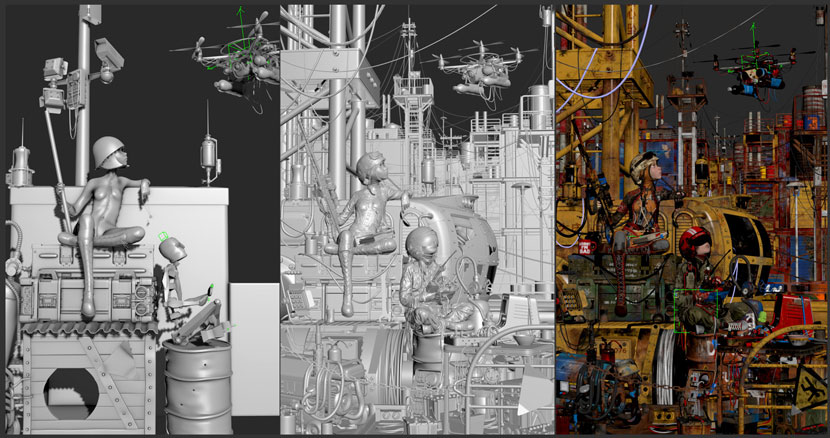 “How rusty were my skies?” Development of Mikhail’s dystopia.
“How rusty were my skies?” Development of Mikhail’s dystopia.
To start off production, I make the blocking of the main objects in the 3D editor, for me that usually means 3ds Max or Maya. I also try to determine the perspective and the key light direction. I render the resulting scene and work on details with overpaint. After that, there is nothing unusual in my pipeline: I make completed 3D models, complementing or partially changing the original composition in the process, and collect the scene. I use ZBrush for sculpting and 3D-Coat for texture painting. When all assets are ready, I collect the scene, fine-tune the materials and lighting and render it through V-Ray. Finally, post processing was done in Photoshop.
What were some of the challenges you had to overcome?
The children, without a doubt, especially the face and figure of the girl. I had never done anything like this in 3D before. The composition also turned out be very challenging. It was difficult to place accents and establish visual hierarchies with so many objects. All in all the project took me about five weeks to complete.
Was there a point during development at which you were afraid of overloading the scene with too many objects?
Every step of the way, honestly. I had to remind myself that this very cramped and cluttered look was an integral part of visual story-telling. With civilization breaking down, the world ends up like a dump.
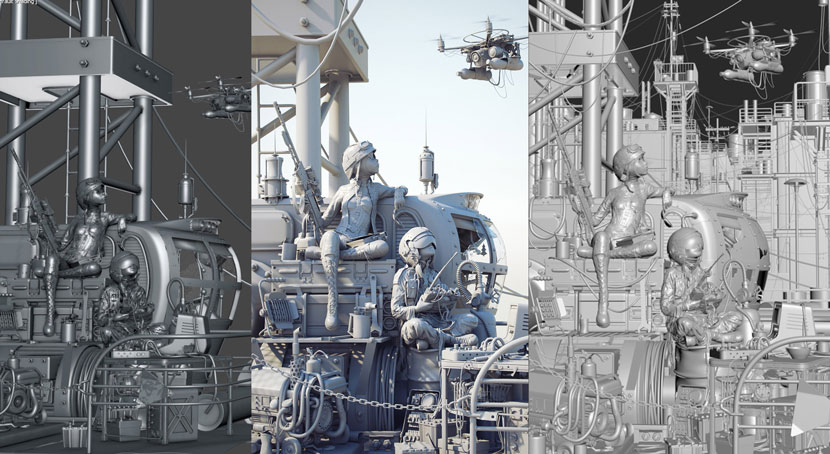 A world takes shape: Fine-tuning the scene while balancing visual hierarchies proved challenging.
A world takes shape: Fine-tuning the scene while balancing visual hierarchies proved challenging.
I find your approach to world-building fascinating! Therefore I am very curious to learn more about your creative vision for this piece. In what reality does the scene take place? How do you imagine this world to be like?
Well, I am an artist, not a writer. While I had a story in mind, I’m sure that the imagination of the audience can tell stories much more interesting. Nonetheless, here are a few key points regarding the overall setting: The scene takes place at the end of the 20th century in East Eurasia, somewhere along the Russian-Chinese border. The whole planet is filled with toxic waste and poisonous mist covers the land. What is left of humanity survives by climbing as high as possible, hastily building structures out of concrete and rusty metal atop the remnants of a now extinct civilization.
Who are the children? What is their purpose and their relationship to each other?
Honestly, I’m not sure. I thought of them as a Slavic girl and an Asian boy, adopted by a former Chinese military pilot and brought up like brother and sister. Regarding their roles, I named them ‘Sentinel’ and ‘Observer’.
What is the function of the makeshift drone controlled by the Observer?
The children use the drone to patrol the area and deliver small packages to nearby settlements.
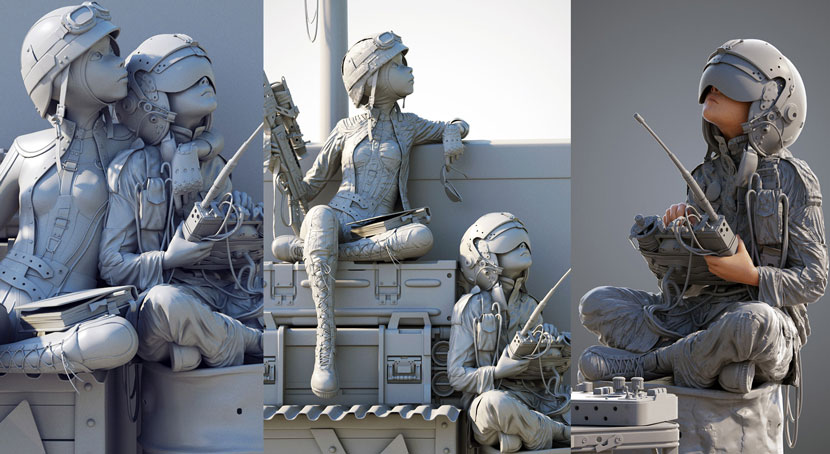 Trying out different poses for the models of ‘The Sentinel’ and ‘The Observer’, the vigilant children shrouded in mystery.
Trying out different poses for the models of ‘The Sentinel’ and ‘The Observer’, the vigilant children shrouded in mystery.
From the writing on the Observer’s helmet to the iPho noodle bowl, there is a lot of subtle story-telling contained in the details. How much of these details did you plan out or were you mostly having fun with it?
Some of the details are designed to provide additional information about the place, time and characters. Others are references to my favorite works in the dystopian genre:
‘Nausicaä of the Valley of the Wind’ by Hayao Miyazaki, ‘We’ by Yevgeny Zamyatin, ’Brave New World’ by Aldous Huxley, ‘Roadside Picnic’ and ‘The Doomed City’ by the Strugatsky brothers and the Fallout and Mad Max universes.
The Chinese inscription I took from an old propaganda poster, it translates to “enemies must be annihilated’.
The Pho Bowl symbolizes my memory of Vietnam. I spent several unforgettable months working in this wonderful country. Xin chào to all my Vietnamese friends!
I found this post-apocalyptic imagery to be somewhat defused by the vibrant colors and cartoony aesthetic. Despite the vigilance of the characters, the scene seems surprisingly calm and peaceful.
I wanted to tell a bright and positive story despite everything. There are children left in this world, and they still maintain their innocent curiosity, read books and explore the world. That means that even in this grim world, there’s still a chance for a better future.
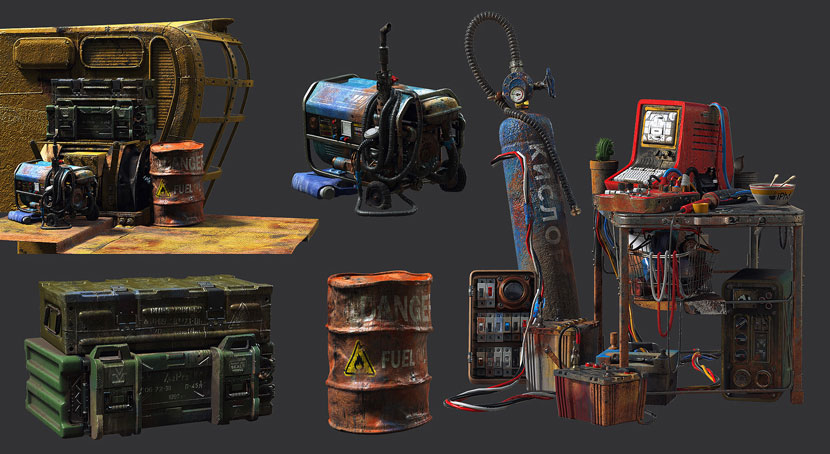 There are a lot of references and visual clues found in the various objects in the scene.
There are a lot of references and visual clues found in the various objects in the scene.
How well was the image received online? Did you get a lot of positive attention and feedback?
‘Rusty Skies’ was very well received and quickly spread through social networks and CGI sites. To this day I still receive a constant stream of messages with praise and requests to buy prints or to write a making of.
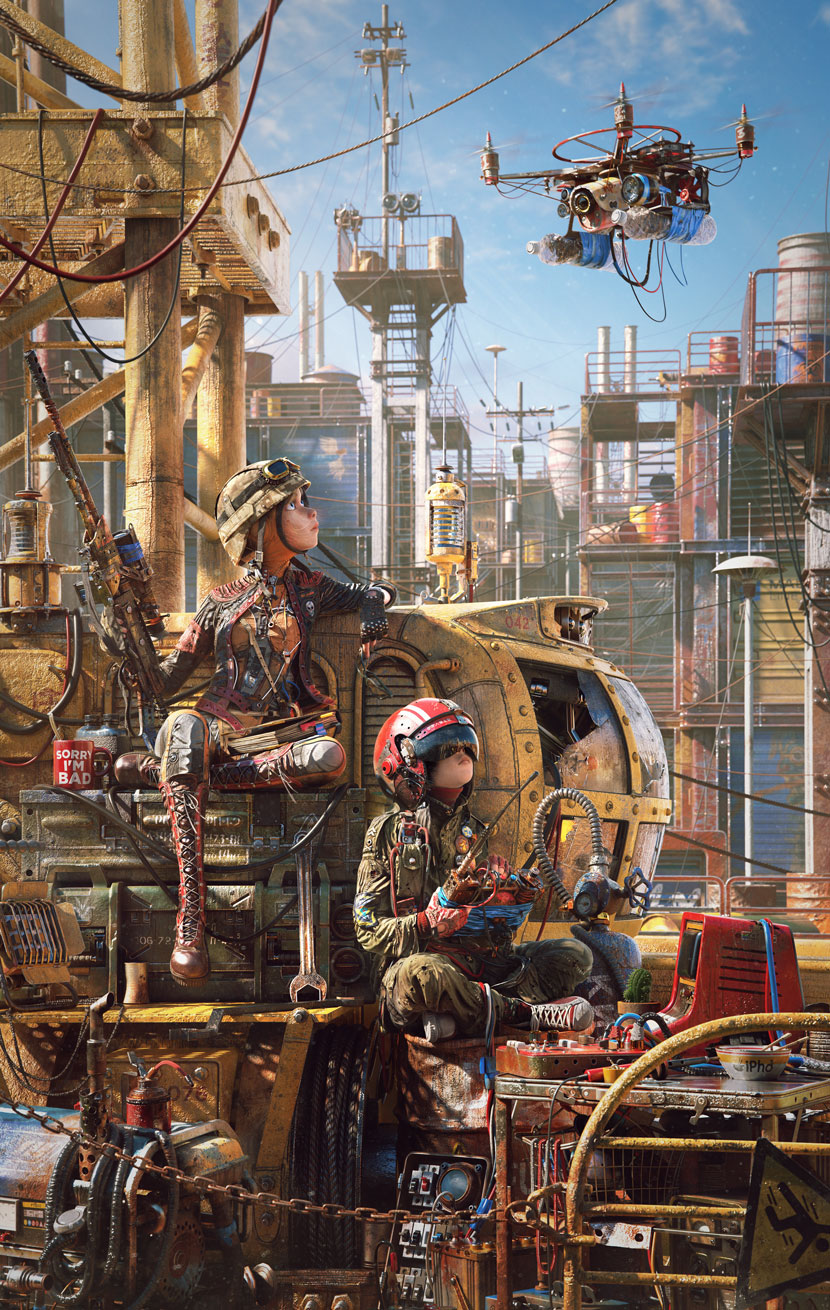 Have a look at all the details in this full shot.
Have a look at all the details in this full shot.
Have you used RebusFarm before? If yes, please tell us more about your overall experience. Is there anything you especially like about our service?
Not yet, unfortunately, but I will definitely try it out soon!
We can’t wait to find out what you will use your RenderPoints on! Thanks for taking the time and all the best in the future.
Keep up with Mikhail Buleyko here:
HOW TO JOIN OUR MONTHLY CONTEST
You want to be our next featured 3D Artist of the Month and win 250 RenderPoints? Just visit our 3D Artist of the Month competition page and submit your entry. We'll choose the best image and contact the winner.
>> Read more articles on our blog
